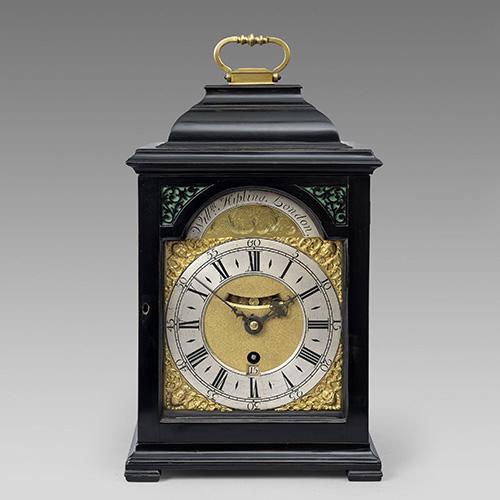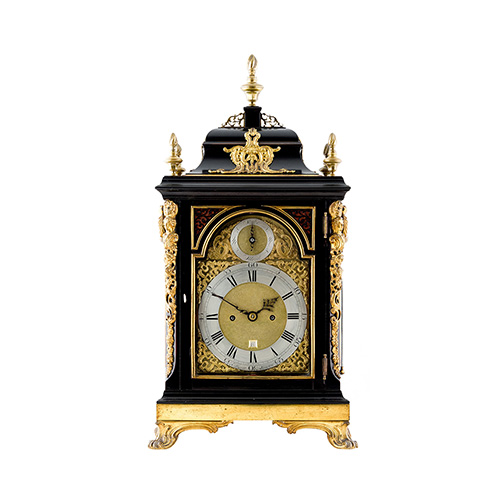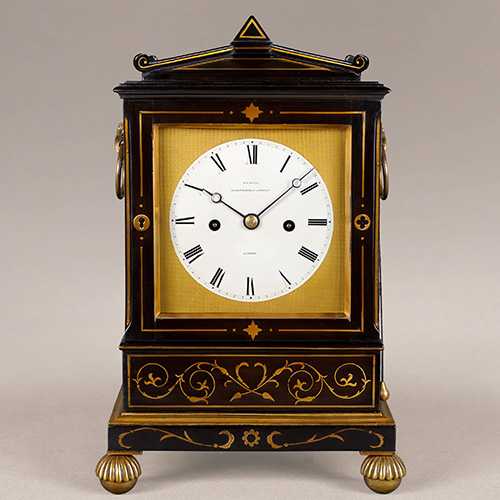

Originally conceived in the mid-17th century, the bracket clock was designed as a small wall-mounted timepiece. The earliest versions were powered by a weight-driven pendulum and stood on a matching wall-mounted shelf which allowed space for the weights to hang. Hence the term bracket clock.
With advancements in horology, weights and pendulums gave way to spring-driven clocks, meaning the bracket itself was no longer an integral part of the clock. Indeed, it is rare these days to find a clock complete with its original bracket, making it difficult for the uninitiated to determine the difference between a table, mantel or bracket clock.
The earliest bracket clocks are usually housed in an ebony case and ornamented with ormolu mounts or brass inlay. As more exotic woods arrived on the market throughout the Hanoverian period, so bracket clocks became common in materials such as mahogany, rosewood and satinwood, together with tortoiseshell veneers and ornate lacquer work decoration.
 Given the hand-crafted nature of their design and scientific advancements in their construction, bracket clocks were luxury items, well beyond the means of all but the wealthiest families. Consequently, it would have been prohibitively expensive to have one in every room. So, as the bracket shelf became redundant, carry handles were added to the design to enable them to be transported conveniently from room to room.
Given the hand-crafted nature of their design and scientific advancements in their construction, bracket clocks were luxury items, well beyond the means of all but the wealthiest families. Consequently, it would have been prohibitively expensive to have one in every room. So, as the bracket shelf became redundant, carry handles were added to the design to enable them to be transported conveniently from room to room.
The elegant timepieces were usually designed as striking clocks, thereby capable of marking the time hourly by means of a striking bell. However, many bracket clocks came with two further features, or complications, as they are known in horological terms.
The first complication is known as a Repeater, which was a lever or pull that when activated allowed the timepiece to strike the hour. Invented by Reverend Edward Barlow in 1676, the mechanism offered an ingenious method of discovering the time throughout the night. Designed for an era well before the use of illuminated dials, the repeater would also have been a great boon for the visually impaired.
 The second, and equally innovative feature, was the introduction of the Silent Pull Repeater. As the term suggests, this was a means of silencing the striking option by means of a pull cord. This enabled the user to mute a bedroom mounted bracket clock, thereby ensuring an undisturbed nights sleep but with the means to tell the time in an instant by using the repeater.
The second, and equally innovative feature, was the introduction of the Silent Pull Repeater. As the term suggests, this was a means of silencing the striking option by means of a pull cord. This enabled the user to mute a bedroom mounted bracket clock, thereby ensuring an undisturbed nights sleep but with the means to tell the time in an instant by using the repeater.
Remove the outer case, and one will usually find the engraving on the backplate is every bit as ornate and beautiful as the design of the exterior. Popularised and produced by the 17th century’s finest master clock makers such as Thomas Tompion and Joseph Knibb, the bracket clock represents a pinnacle of Georgian horological excellence.
Click here to view a selection of bracket clocks currently available from BADA members.

